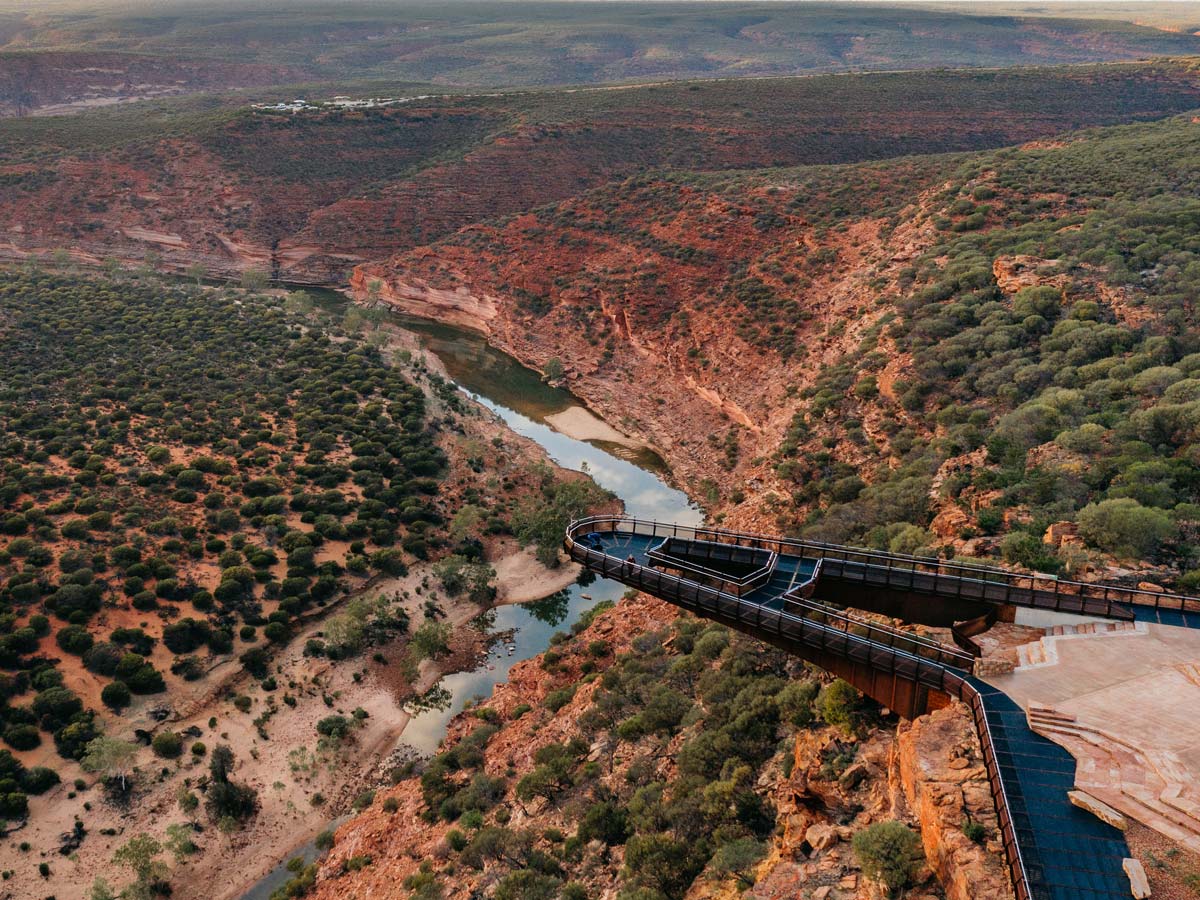27 October 2022
![]() 5 mins Read
5 mins Read

Find the complete list of the Top 50 Aussie Towns here.
Kalbarri has become my family’s accidental winter getaway. I say accidental because I never planned it to morph into an annual tradition. It was meant to be a quick stopover on our way to the dugong and dolphin zones of Shark Bay, another four hours north. But Kalbarri has charmed us with its slow unfurling of natural beauty. We stayed two nights one year, then booked a week, and now seven days seems barely enough.

You’ll find the town on Australia’s Coral Coast. (Image: Tourism WA)
Kalbarri lies about 6.5 hours’ drive from Perth, just enough to make it an effort. The reward is an off-the-highway town with more locals than holiday houses, where people go because they want to, not because they have to. Clustered on the land of the Nanda people, the population sits a touch over 1500.
The community curls around a still inlet fed by the Murchison River, which empties into a roaring, rock-skewered ocean channel that fishing vessels and one whale-watching boat nimbly navigate in zigzag fashion.

The community of Kalbarri curls around a still inlet.
Following the direction of each waterway reveals Kalbarri’s beauty spots, hidden until you know where to look. On the ocean side, there’s barely a hint of the gaping coastal gorges that yawn just below the single road into town. Brown tourist signs point to spots like Mushroom Rock, Pot Alley and Red Bluff, seriously downplaying the beauty of wind-carved strata layers painted in cinnamon rainbows that rise more than 100 metres above seething ocean.
Mushroom Rock is an easy, 1.5-kilometre circular loop walk that we hike each year. At the base of a mottled valley, there is indeed a rock that vaguely resembles a Swiss brown, but more fascinating still are the finger shaped rocks that dangle, like stalactites, from sandstone overhangs further up the hill. They’re ancient, giant worm burrows that suit the moonscape setting.
Pot Alley is our favourite sunset spot. Its red ochre tones glow as dusk falls, with air-pocked layers of rock catching the golden light and beaming like a campfire.
Setting up fold-out chairs, we clink glasses and slice cheese from a rock platform, our eyes flicking between ocean and the jutting headlands. On several occasions, we are the only ones there.

Here, the Indian Ocean meets ancient landscapes. (Image: Tourism WA)
Red Bluff is the area’s top whale-watching spot, a known fact that makes it popular with dozens of walkers following the paved trail to a small, crow’s nest-like lookout. I lose count of the cetaceans I spot lifting their two-toned forms from the water, as they migrate past from July until November.

The vibrant contrasts of Red Bluff meeting the ocean. (Image: Tourism WA/ @from.miles.away)
There are more gorges 35 kilometres inland, inside 180,000 hectares of Kalbarri National Park. Having snapped ourselves framed by the rock formation Nature’s Window and scrambled down the rock ladders of the River Trail, we head to Kalbarri Skywalk, which was constructed for $25 million in 2020.

The Kalbarri Skywalk unfurls over breathtaking rock formations. (Image: Tourism WA)
Its twin structures stretch out like A-shaped catwalks, overlooking 400-million-year-old rock formations. It’s impressive during the day, but perhaps even more so by night, when the ranges opposite are cloaked in darkness.
We return by night with D’Guy Charters, which runs stargazing experiences atop the Skywalk. The Milky Way drifts silently above without another soul within cooee; it’s just us, a telescope and a high-powered laser.

Stargaze at Nature’s Window. (Image: Tourism WA)
Eager to see a side of the national park that’s inaccessible to most, we join Kalbarri Adventure Tours for a half-day off-road adventure to a tranquil river beach. Canoeing along the rockface, as gorges loom high, some with waterfalls from winter rains, is the highlight of our holiday.

The wild beauty of Kalbarri from above. (Image: Tourism WA)
There aren’t many shops in Kalbarri – a couple of surf boutiques, a souvenir shop, a small IGA – and dinner options are limited (I go for the food trucks by the harbour).
One evening, we spread out a feast on a public picnic table (tip: buy consumables in Geraldton on the drive up) and let the kids loose on the foreshore playground. As we watch the sky fade to peach, we hear the distinctive tinkle of a piano.
In the car park, a young man has driven in with his upright piano bolted to a custom trailer. With no hat out for donations, I ask him what his caper is. “I’m a fly-in-fly-out worker and I don’t get to play much,” he says.
“The piano was taking up lots of room in my house and I didn’t like all the noise at home, so I decided to build a trailer for my car and take it outside.” He tows it to all sorts of unlikely natural settings, playing purely for pleasure.
His songs fill the cooling night air and, as we pack away our goodies, I hope I’ll see him again next year.
LEAVE YOUR COMMENT